Reinforced Concrete Plates under Impact Load—Damage Quantification
Abstract
:1. Introduction
2. Specimens, Experimental Setup and Summary of the Experiments
2.1. Specimen
2.2. Experimental Schedule
2.3. Experimental Setup
3. Preliminary Considerations on the Description of Global Damage
4. Experimental Results—Occurring Damage
4.1. Local Damage—Scabbing and Spalling
4.2. Local Damage—Punching Shear Failure
4.3. Global Damage
5. Conclusions and Outlook
- (1)
- At first it should be stated that an explicit classification of damage degree depending on the impactor impact velocity is only possible to a limited extent. This can be easily shown on the example of the RC_1 and RC_5 test specimens. For both plates, the global degrees of damage Φglobal are about 50%. But despite the same numerical values for the damage degree, the boundary conditions of these experiments differ considerably with regard to the velocity of the impactor and the associated local damage of the component. Thus, it has to be concluded that Φglobal cannot be used as an exclusive criterion for the damage description. Instead, the combination of global and local damage of the structure must always be considered in context. The interaction of both types of damage was underestimated.
- (2)
- It should be noted that the investigations carried out are of selective nature. Scattering in the experimental results due to varying material parameters or geometries were not specifically recorded and can therefore not be evaluated in general.
- (3)
- It has to be examined whether an extension of the damage description has to be made with regard to the possible change of the support conditions due to the impact. In the experiments presented, the laboratory environment ensured that the static system before and after the impact event was identical. In reality, a change of the support conditions due to an extreme loading event has to be considered.
- (4)
- It is also not yet possible to estimate the susceptibility to errors of the described method, as the number of experiments does not allow this.
- (5)
- An objective description and evaluation of the effect of subsequently applied strengthening layers is possible using the different damage characteristics. The method is particularly suitable for direct comparison of the effectiveness of different material combinations which can be used for strengthening.
Author Contributions
Funding
Acknowledgments
Conflicts of Interest
References
- Jonas, W.; Rüdiger, E.; Riech, H. Rs 165—i. Technischer Bericht—Kinetische Grenztragfähigkeit, Rs 165—Grenztragfähigkeit Von Stahlbetonplatten Bei Hohen Belastungsgeschwindigkeiten (z.B. Flugzeugabsturz); Hochtief AG: Frankfurt, Germany, 1978. [Google Scholar]
- Heine, H.; Hoffschult, A.; Wösten, B.; Jonas, W.; Rüdiger, E.; Riech, E. Rs 149, Rs 165—ii. Technischer Bericht—Versuchseinrichtung, Rs 165—Grenztragfähigkeit Von Stahlbetonplatten Bei Hohen Belastungsgeschwindigkeiten (z.B. Flugzeugabsturz); Rs 149—Untersuchung Der Widerstandsfähigkeit Von Betonstrukturen Gegen Flugzeugabsturz; Hochtief AG: Frankfurt, Germany, 1980. [Google Scholar]
- Jonas, W.; Rüdiger, E.; Riech, H. RS 165, (RS 149)—III. Technischer Bericht—Stoßlast Deformierbarer Projektile, RS 165—Grenztragfähigkeit von Stahlbetonplatten Bei Hohen Belastungsgeschwindigkeiten (z.B. Flugzeugabsturz); RS 149—Untersuchung Der Widerstandsfähigkeit Von Betonstrukturen Gegen Flugzeugabsturz; Hochtief AG: Frankfurt, Germany, 1981. [Google Scholar]
- Jonas, W.; Rüdiger, E.; Gries, M.; Riech, H.; Rützel, H. RS 165—IV. Technischer Bericht—Schlussbericht—Kinetische Grenztragfähigkeit Von Stahlbetonplatten, RS 165—Grenztragfähigkeit von Stahlbetonplatten Bei Hohen Belastungsgeschwindigkeiten (z.B. Flugzeugabsturz) [Final Report]; Hochtief AG: Frankfurt, Germany, 1982. [Google Scholar]
- Sugano, T.; Tsubota, H.; Kasai, Y.; Koshika, N.; Orui, S.; von Riesemann, W.A.; Bickel, D.C.; Parks, M.B. Full-scale aircraft impact test for evaluation of impact force. Nucl. Eng. Des. 1993, 140, 373–385. [Google Scholar] [CrossRef]
- Sugano, T.; Tsubota, H.; Kasai, Y.; Koshika, N.; Ohnuma, H.; von Riesemann, W.A.; Bickel, D.C.; Parks, M.B. Local damage to reinforced concrete structures caused by impact of aircraft engine missiles Part 1. Test program, method and results. Nucl. Eng. Des. 1993, 140, 387–405. [Google Scholar] [CrossRef]
- Sugano, T.; Tsubota, H.; Kasai, Y.; Koshika, N.; Itho, C.; Shirai, K.; von Riesemann, W.A.; Bickel, D.C.; Parks, M.B. Local damage to reinforced concrete structures caused by impact of aircraft engine missiles Part 2. Evaluation of test results. Nucl. Eng. Des. 1993, 140, 407–423. [Google Scholar] [CrossRef]
- Orbovic, O.; Blahoianu, A. Tests on Concrete Slabs under Hard Missile Impact to Evaluate the Influence of Transverse Reinforcement and Pre-Stressing on Perforation Capacity. In Proceedings of the 21st International Conference on Structural Mechanics in Reactor Technology (SMiRT-21), New Delhi, India, 6–11 November 2011. Division V: Paper ID# 162, 8p. [Google Scholar]
- Orbovic, N.; Blahoianu, A. Tests to determine the influence of transverse reinforcement on perforation resistance of RC slabs under hard missile impact. In Proceedings of the 22nd International Conference on Structural Mechanics in Reactor Technology (SMiRT-22), San Francisco, CA, USA, 18–23 August 2013. Division V, 10p. [Google Scholar]
- Just, M.; Curbach, M.; Kühn, T.; Hering, M. Bauteilverhalten unter stoßartiger Beanspruchung durch aufprallende Behälter (Flugzeugtanks)—Phase 1a: Maßstabseffekte bei stoßartiger Beanspruchung; Final Report, Project Reaktorsicherheitsforschungs-Vorhaben No. 1501438; TU Dresden: Dresden, Germany, 2016. [Google Scholar] [CrossRef]
- Hering, M.; Kühn, T.; Curbach, M. Bauteilverhalten unter stoßartiger Beanspruchung durch aufprallende Behälter (Flugzeugtanks)—Phase 1B: Quantifizierung der Schädigungen des Betongefüges, Teilprojekt: Fallturmversuche; Final Report, project Reaktorsicherheitsforschungs-Vorhaben No. 1501479; TU Dresden: Dresden, Germany, 2017. [Google Scholar] [CrossRef]
- NEA/CSNI. Improving Robustness Assessment Methodologies for Structures Impacted by Missiles (IRIS_2010); Nuclear Energy Agency/Committee on the Safety of Nuclear Installations: Paris, France, 2012. [Google Scholar]
- NEA/CSNI. Improving Robustness Assessment Methodologies for Structures Impacted by Missiles (IRIS_2012); Nuclear Energy Agency/Committee on the Safety of Nuclear Installations: Paris, France, 2014. [Google Scholar]
- Curosu, I.; Mechtcherine, V.; Hering, M.; Curbach, M. Mineral-bonded composites for enhanced structural impact safety—Overview of the format, goals and achievements of the research group GRK 2250. In Proceedings of the 10th International Conference on Fracture Mechanics of Concrete and Concrete Structures, Bayonne, France, 23–26 June 2019; Pijaudier-Cabot, G., Grassl, P., La Borderie, C., Eds.; p. 12. [Google Scholar] [CrossRef]
- Hering, M.; Bracklow, F.; Kühn, T.; Curbach, M. Impact experiments with reinforced concrete plates of different thicknesses. Struct. Concr. 2020, 21, 587–598. [Google Scholar] [CrossRef]
- Cherif, C.; Zierold, K.; Curbach, M.; Hering, M. Final Report IGF-Project No. 19009 BG “Textilverstärkte Betonkonstruktionen Für Impaktbeanspruchungen (Impakt-Textilbeton-Konstruktionen)”; TU Dresden: Dresden, Germany, 2019. [Google Scholar]
- Hering, M. Untersuchung von mineralisch gebundenen Verstärkungsschichten für Stahlbetonplatten gegen Impaktbeanspruchungen (Investigation of mineral-bonded strengthening layers for reinforced concrete plates against impact loads). Ph.D. Thesis, TU Dresden, Dresden, Germany, 12 May 2020. in print. [Google Scholar]
- DIBt. Verfahren zur Verstärkung von Stahlbeton mit TUDALIT (Textilbewehrter Beton), 1st ed.; DIBt: Berlin, Germany, 2014; update 2016. [Google Scholar]
- Scheerer, S.; Schütze, E.; Curbach, M. Strengthening and Repair with Carbon Concrete Composites—The First General Building Approval in Germany. In Proceedings of the SHCC4—International Conference on Strain-Hardening Cement-Based Composites, Dresden, Germany, 18–20 September 2017; Mechtcherine, V., Slowik, V., Kabele, P., Eds.; Springer: Dordrecht, The Netherlands, 2018; pp. 743–751. [Google Scholar]
- Bangash, M.Y.H. Shock, Impact and Explosion—Structural Analysis and Design; Springer: Berlin, Germany, 2009. [Google Scholar]
- Eibl, J.; Kreuser, K. Versuche zum Verhalten unterschiedlicher Stahlsorten in stoßbeanspruchten Platten; Deutscher, A.S., Ed.; Beuth Verlag GmbH: Berlin, Germany, 1986. [Google Scholar]
- Eibl, J.; Keintzel, E.; Charlier, H. Dynamische Probleme im Stahlbetonbau–Teil II: Stahlbetonbauteile und -Bauwerke unter dynamischer Beanspruchung; Deutscher, A.S., Ed.; Beuth Verlag GmbH: Berlin, Germany, 1988. [Google Scholar]
- Nerger, D.; Moosavi, R.; Bracklow, F.; Hering, M.; Kühn, T.; Curbach, M.; Hille, F.; Rogge, A. Planar tomography and numerical analysis for damage characterization of impact loaded RC plates. Civ. Eng. Des. 2020. [Google Scholar] [CrossRef]
Publisher’s Note: MDPI stays neutral with regard to jurisdictional claims in published maps and institutional affiliations. |
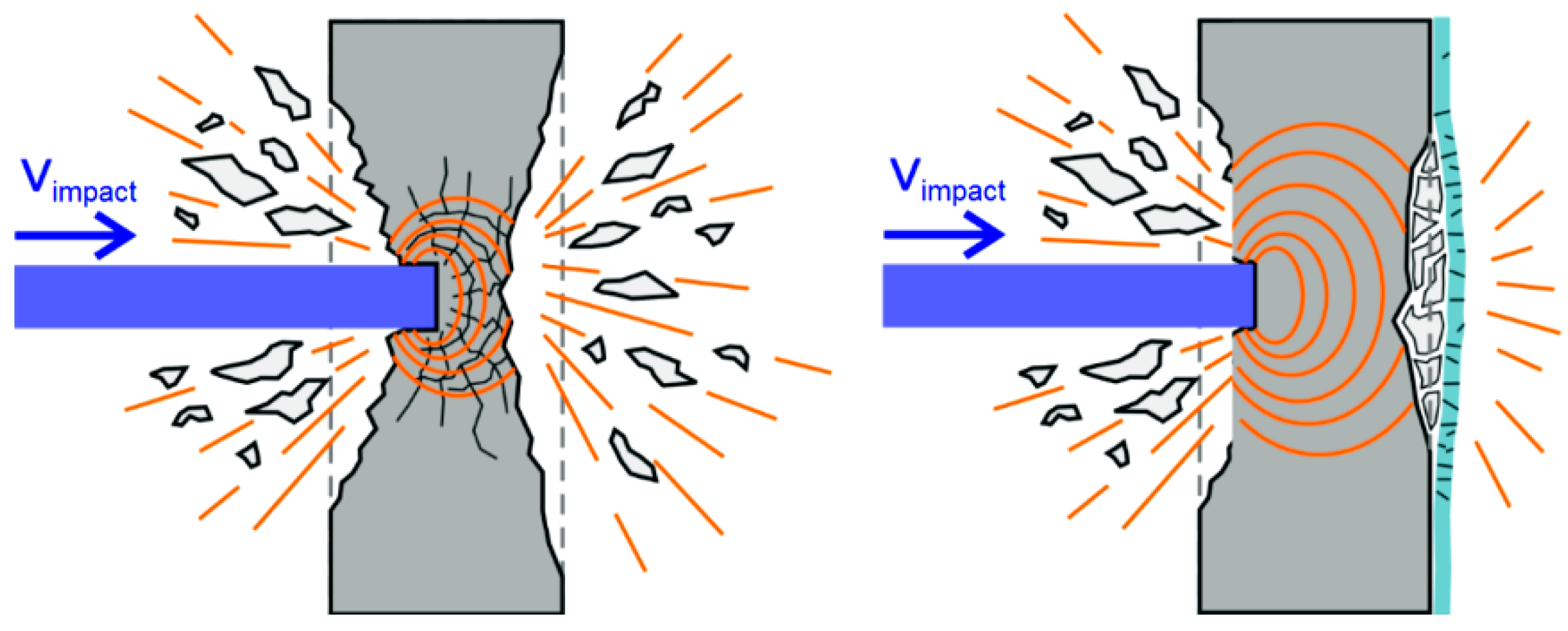
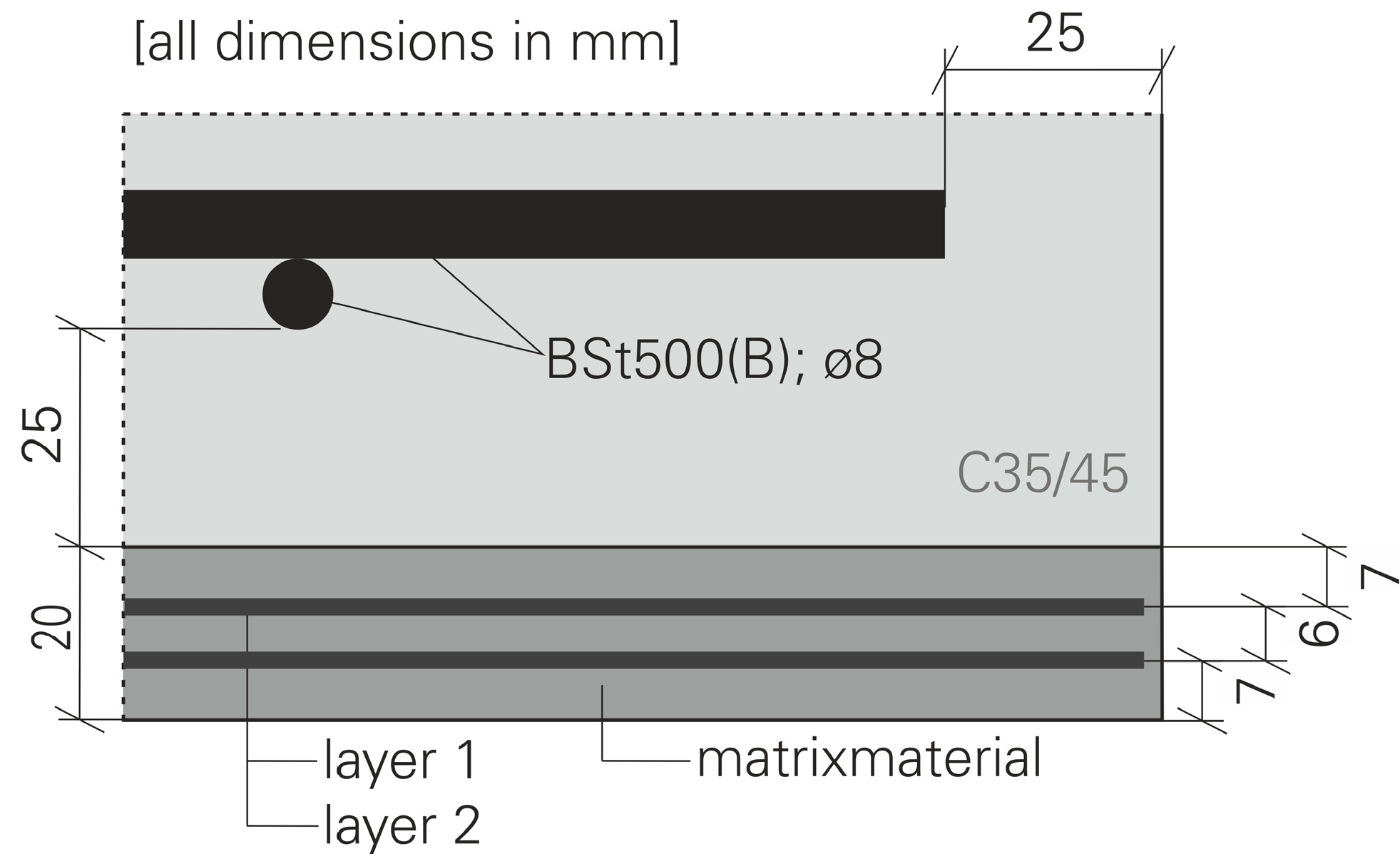

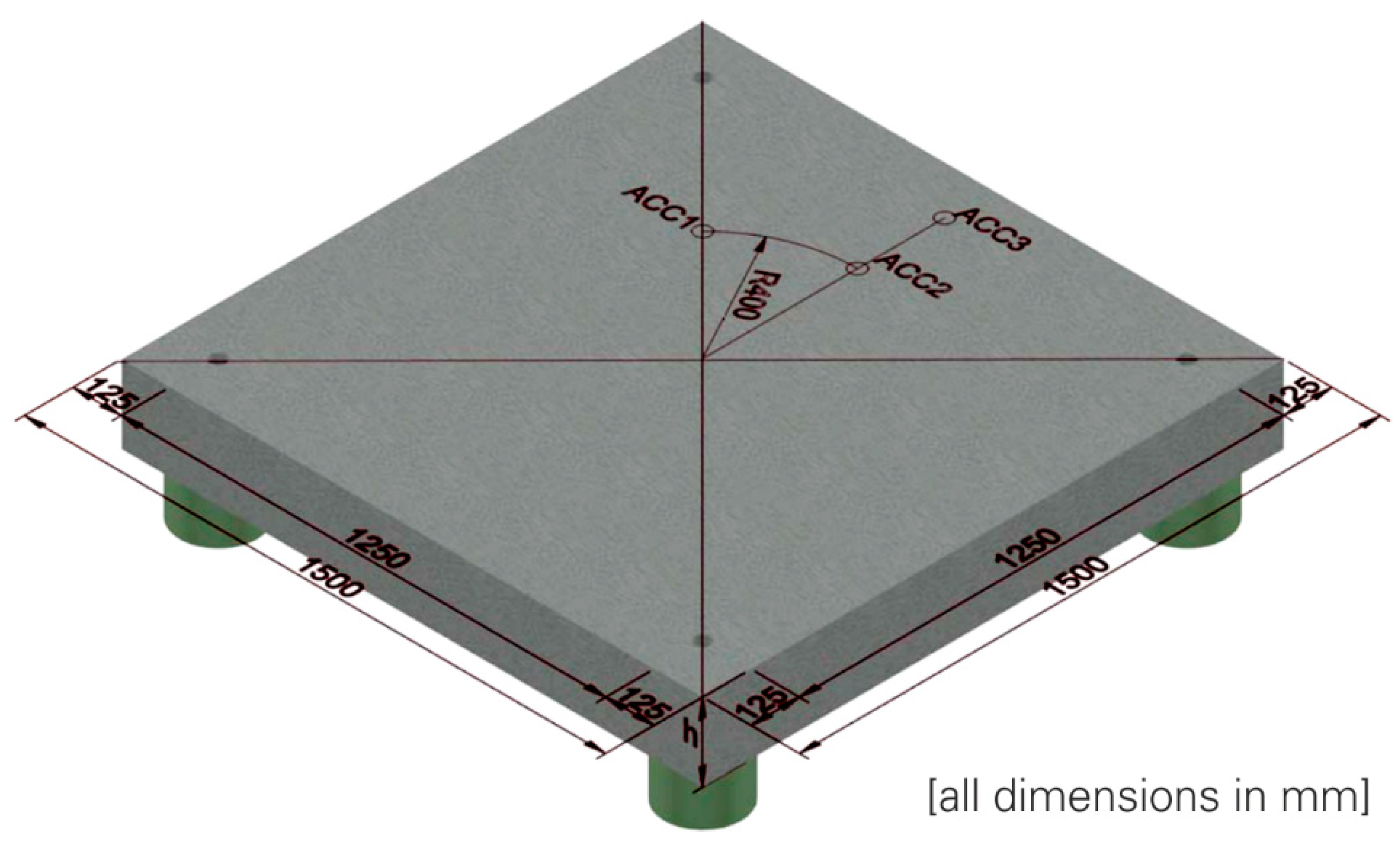
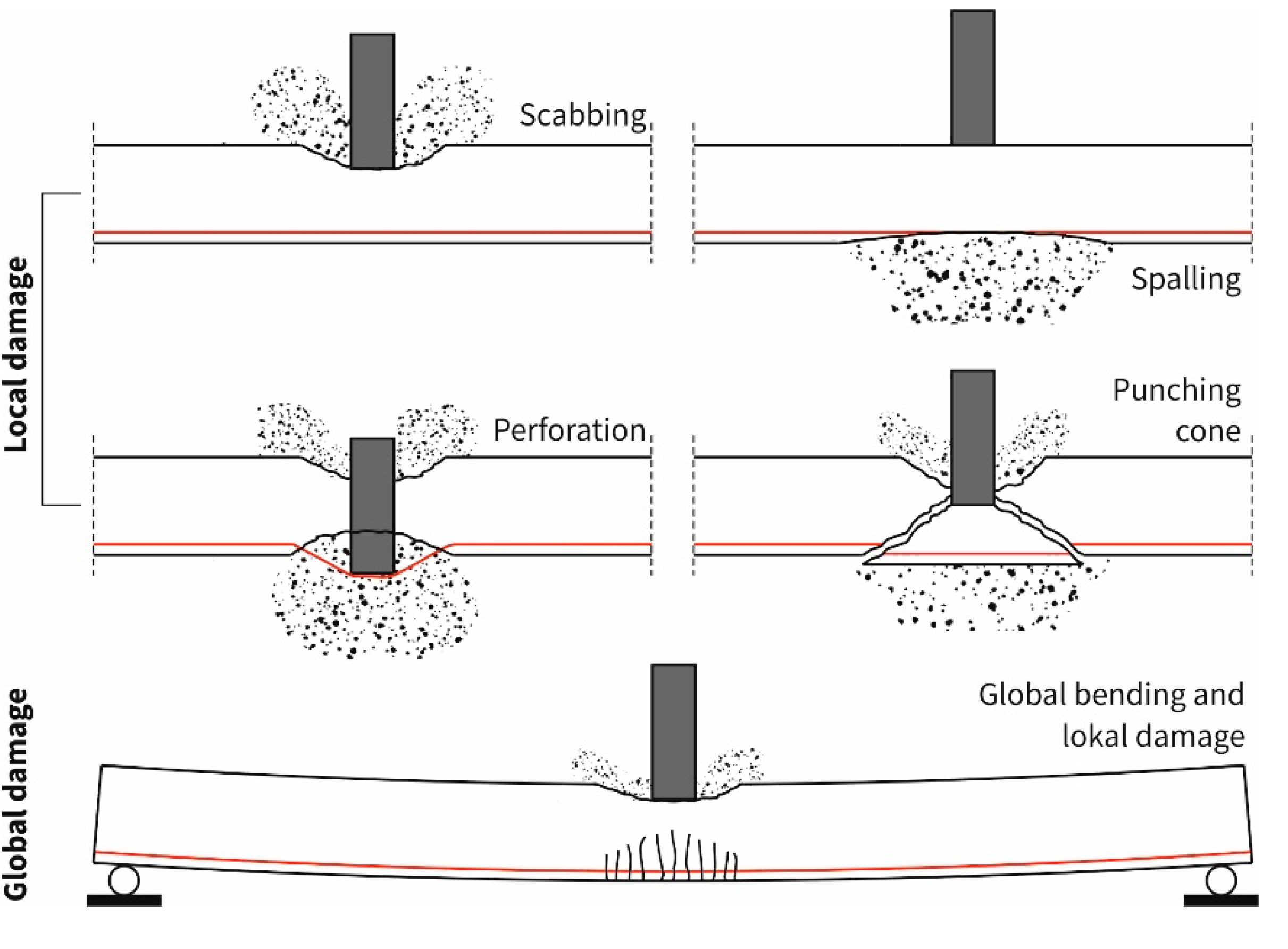

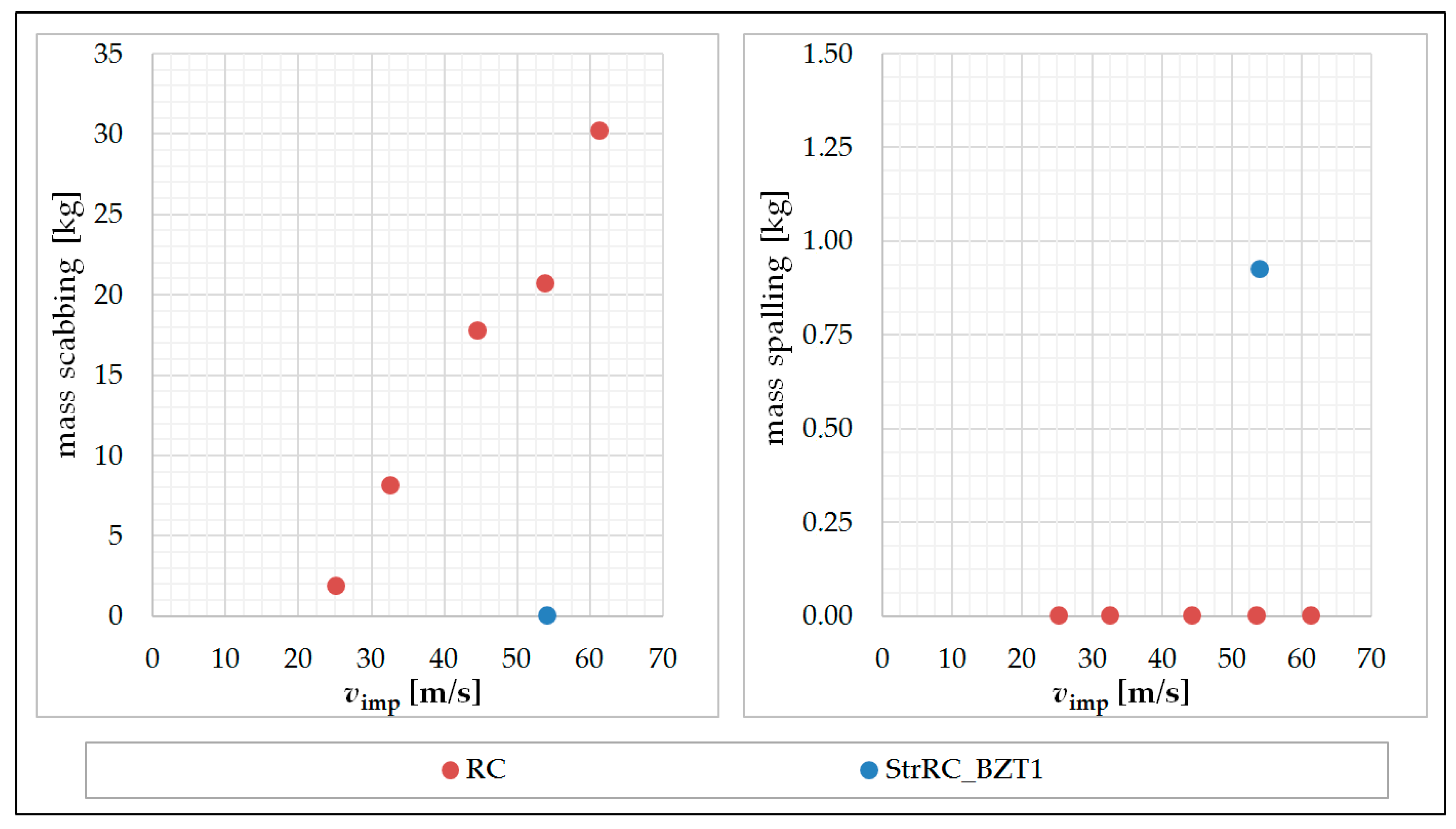



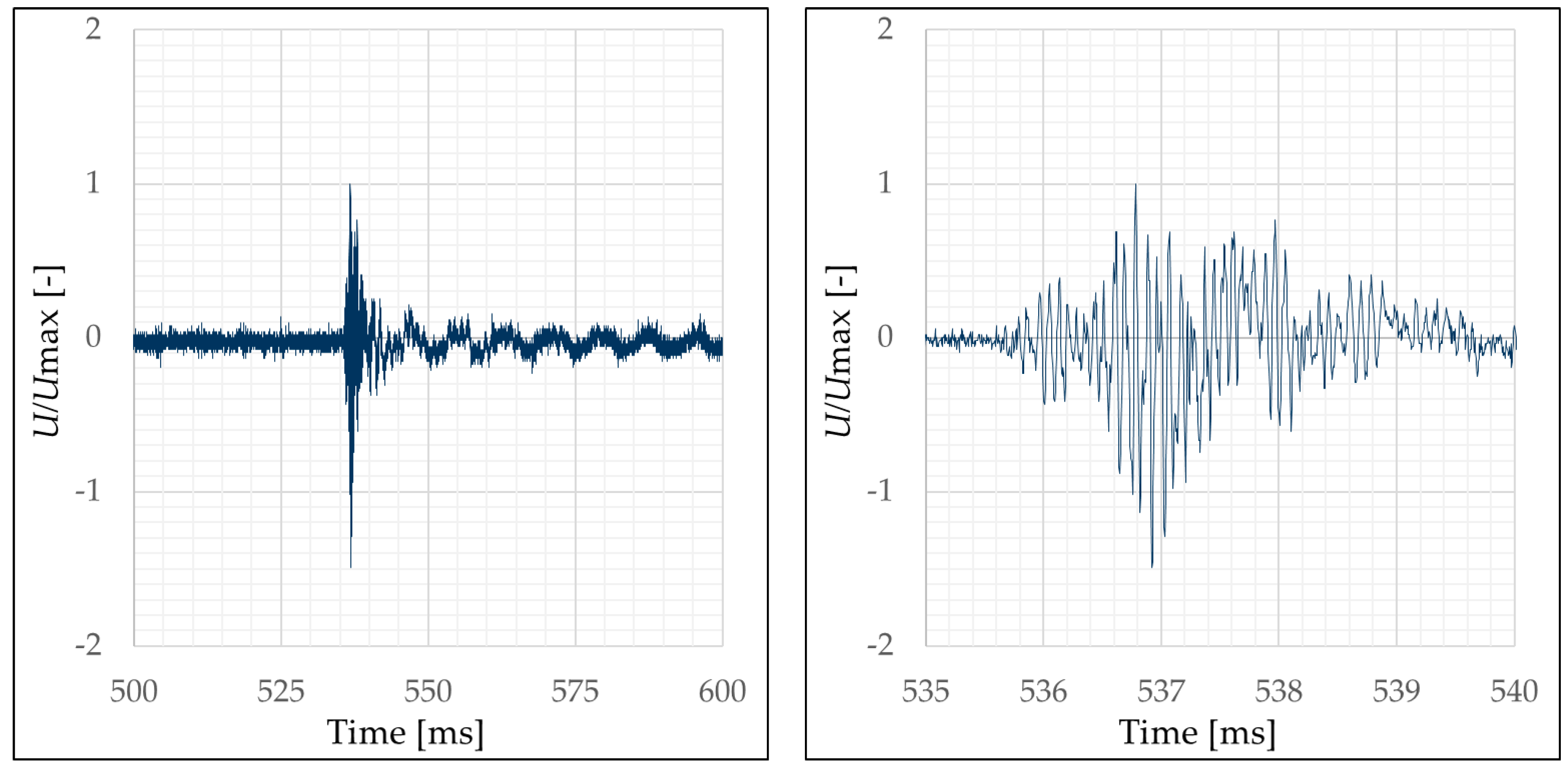
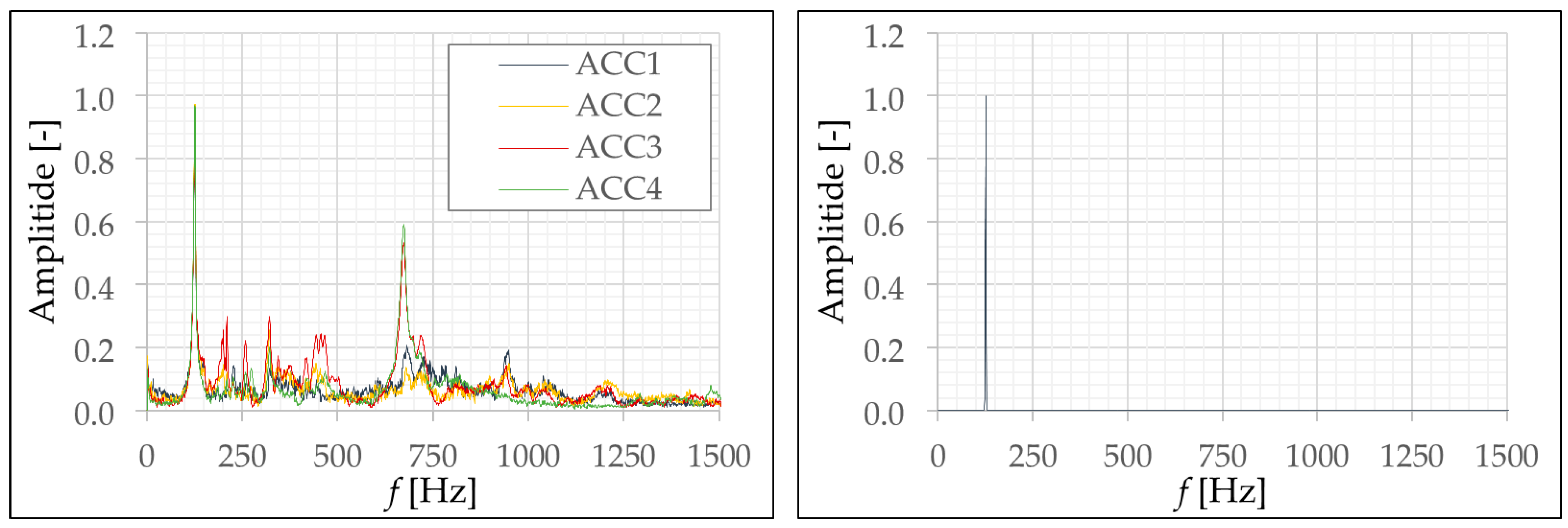
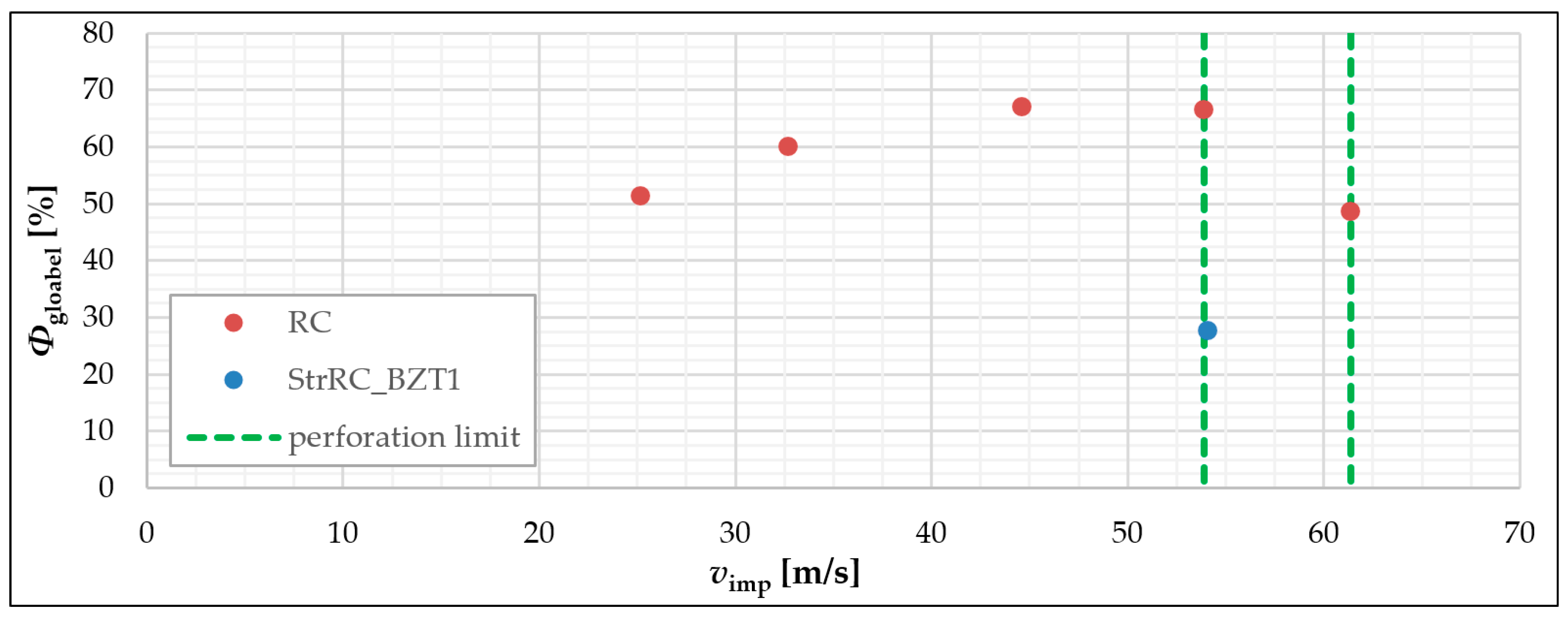
| Plate Label | Plate Number According to [15,17] | Impactor Velocity * vimp [m/s] | Impactor Energy * [J] |
|---|---|---|---|
| RC_1 | PL124 | 25.2 | 6877.5 |
| RC_2 | PL121 | 32.7 | 11,580.4 |
| RC_3 | PL120 | 44.6 | 21,542.6 |
| RC_4 | PL122 | 53.9 | 31,463.4 |
| RC_5 | PL123 | 61.4 | 40,828.7 |
| StrRC_BZT1 | PL125 | 54.1 | 31,697.4 |
| Eigenmode | ACC1 | ACC2 | ACC3 | ACC4 |
|---|---|---|---|---|
| Eigenmode 1 | X | X | X | X |
| Eigenmode 2 | O | X | X | O |
| Eigenmode 3 | X | X | X | O |
| Eigenmode 4 | O | X | X | O |
| Plate Label | Impactor Velocity ** vimp [m/s] | Plate Mass before Impact m1 [kg] | Plate Mass after Impact m2 [kg] | Scabbing Mass mscabb [kg] | Spalling Mass mspall [kg] |
|---|---|---|---|---|---|
| RC_1 | 25.2 | 988.00 | 986.10 | 1.90 | 0.00 |
| RC_2 | 32.7 | 990.00 | 981.90 | 8.10 | 0.00 |
| RC_3 | 44.6 | 996.00 | 978.26 | 17.74 | 0.00 |
| RC_4 | 53.9 ** | 1002.00 | 981.32 | 20.68 | 0.00 |
| RC_5 | 61.4 | 958.22 | 928.00 | 30.20 | 0.00 |
| StrRC_BZT1 | 54.1 | 1092.00 | 1091.08 | 0.00 | 0.92 |
| Stimulation No. | Position of the Plate |
|---|---|
| St1 | free hanging before the impact experiment |
| St2 | free lying before the impact experiment |
| St3 | clamped on load cells before the impact experiment |
| St4 | clamped on load cells after the impact experiment |
| St5 | free lying after the impact experiment |
| St6 | free hanging after the impact experiment |
| Specimen Label | fE,St1 [Hz] | fE,St2 [Hz] | fE,St3 [Hz] | fE,St4 [Hz] | fE,St5 [Hz] | fE,St6 [Hz] | Φglobal [%] |
|---|---|---|---|---|---|---|---|
| RC_1 | 311.0 | 65.0 | 110.5 | 80.5 | 49.8 | 182.5 | 51.3 |
| RC_2 | 308.5 | ##,# | 115.5 | 82.0 | ##,# | 169.0 | 60.1 |
| RC_3 | 311.0 | 116.8 | 126.0 | 81.5 | 73.3 | 138.0 | 67.0 |
| RC_4 | 317.0 | 99.3 | 120.0 | 76.0 | 60.5 | 159.5 | 66.5 |
| RC_5 | 307.5 | 91.0 | 117.0 | 85.5 | 79.0 | 169.5 | 48.6 |
| StrRC_BZT1 | 391.0 | 64.4 | 91.8 | 89.0 | 60.3 | 232.5 | 27.7 |
© 2020 by the authors. Licensee MDPI, Basel, Switzerland. This article is an open access article distributed under the terms and conditions of the Creative Commons Attribution (CC BY) license (http://creativecommons.org/licenses/by/4.0/).
Share and Cite
Hering, M.; Bracklow, F.; Scheerer, S.; Curbach, M. Reinforced Concrete Plates under Impact Load—Damage Quantification. Materials 2020, 13, 4554. https://doi.org/10.3390/ma13204554
Hering M, Bracklow F, Scheerer S, Curbach M. Reinforced Concrete Plates under Impact Load—Damage Quantification. Materials. 2020; 13(20):4554. https://doi.org/10.3390/ma13204554
Chicago/Turabian StyleHering, Marcus, Franz Bracklow, Silke Scheerer, and Manfred Curbach. 2020. "Reinforced Concrete Plates under Impact Load—Damage Quantification" Materials 13, no. 20: 4554. https://doi.org/10.3390/ma13204554





